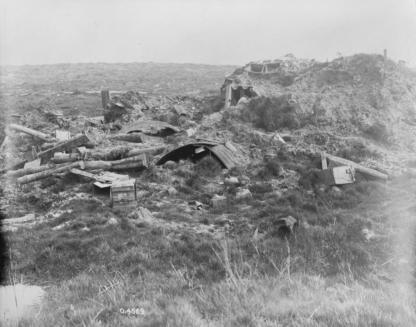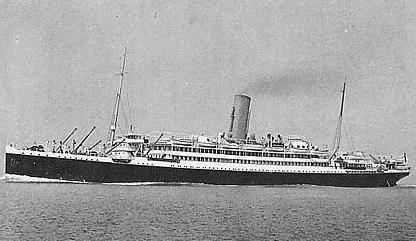
copyright © Wartime Heritage Association
Website hosting courtesy of Register.com - a web.com company
Wartime Heritage
ASSOCIATION
At the age of 24, Amos Hilton Forbes enlisted with the 9th Regiment Canadian Mounted
Rifles at North Battleford, Saskatchewan on January 8, 1915. He was five feet, ten inches in
height and weighed 170 lbs. He had a dark complexion, grey eyes and brown hair.
He departed Canada on November 23 and arrived in England on December 3, 1915 where he
served for two months. On transfer to France on January 29, 1916, he was taken on strength with
the 1st Canadian Mounted Rifles on January 29, 1916.
The Battle of Mount Sorrel (June 2 -13 1916)
The 1st Canadian Mounted Rifles, along with the 4th Canadian Mounted Rifles, were manning
the 3rd Division's front on June 2, 1916, when the German army launched an assault to take the
last dominating observation position in front of Ypres and keep as many British units as possible
pinned down in the area, to avoid them assisting the obvious build up on the Somme or relieving
more French units to go to the defence of Verdun.
At approximately 10:00 am on June 2, the Germans
began an intensified bombardment on the front lines and half
a mile behind them. The shellfire continued and intensified
yet again at 12:30 pm, as the British front line, trenches, wire
defences, and dugouts were destroyed. The British artillery
responded, but gradually it became less effective as telephone
lines were cut by shellfire, and all of the forward observation
officers in the front lines became casualties.
At just after 1pm, the German pioneers blew a small
number of mines just short of the destroyed British fire trench
at Mount Sorrel. The German infantry now advanced. The
main strength fell against the 4th and 1st Canadian Mounted
Rifles. Despite efforts to halt the attack the fight for the shell
holes of the old front line was dogged, with much hand to
hand combat. The Germans overran the British line, capturing
the heights at Mount Sorrel and Tor Top and advancing some
way down the slope to take a number of strong points. As the defenders recovered and the enemy came into view on the
downward slope, fire intensified and the Germans halted, consolidating their gains.
Between June 2 and June 14, the Canadian Corps lost a total of 73 officers and 1053 other ranks killed; 257 officers
and 5010 other ranks wounded; 57 officers and 1980 other ranks missing, a total of 8430.
On June 2, 1916 Amos Hilton Forbes was reported missing in action. Wounded and buried by a shell explosion in the
field he was taken a prisoner of war. It was unofficially reported that he was a prisoner, at Wahn, Germany (June 13, 1916)
wounded, and having sustained burns to his neck and face. It was then officially reported he was at Aachen, Germany (August
12, 1916) and transferred to Julich, Germany (September 6, 1916). He was then reported to have been moved to Stendal
Sachsen (November 25, 1916) and then reported to be held at Palace Hotel, Murren, Switzerland (January 11, 1917) and was
part of an exchange in September, 1917.
An agreement between the International Committee of the Red Cross and the Swiss government with the warring
parties was signed in 1914. Prisoners of war who were too seriously wounded or sick to be able to continue in military
service were to be repatriated through Switzerland, with the assistance of the Swiss Red Cross. Groups of Swiss doctors
visited prisoner of war camps to select potential internees. Once a prisoner of war had been selected, he would be brought
before a board comprising two Swiss Army doctors, two doctors from the country holding him captive, and a representative
of the prisoner’s own nation.
By the end of 1916, some 27,000 former prisoners of war were interned in Switzerland. By the end of the war, nearly
68,000 men had been interned in Switzerland. Amos Hilton Forbes was part of an exchange in September, 1917.
With his release from Switzerland Amos Forbes was
transferred to 1st London General Hospital at Camberwell on
September 11, 1917 and to the Canadian Convalescent Hospital
on September 19, 1917 suffering from shell shock and deafness
resulting from the shell explosion in June 1916. It was decided
to discharge him to Canada and he sailed on the HS Araguaya
from Liverpool, England to Halifax, Nova Scotia on October 17,
1917 arriving in Canada on October 25, 1917. He was
transferred to a convalescent hospital in Regina until his
discharge in February 1918.
Amos Hilton Forbes died on December 11, 1940
Sources/Additional Information:
http://curlinghistory.blogspot.ca/2015/03/the-ww1-internees-who-curled-at-murren.html
http://www.longlongtrail.co.uk/battles/battles-of-the-western-front-in-france-and-flanders/actions-in-the-spring-of-1916-western-front/#sorrel
The Battle of Mount Sorrel
Amos Hilton Forbes


Mount Sorrel
Photo: Dept. of National Defence/Library and Archives Canada

Hospital Ship Araguaya


- World War I - Menu
- WWI Stories and Articles
- Photos - Yarmouth Soldiers
- Selection of World War I Songs
- WWI Casualties of Yarmouth, NS
- Those Who Served - Yarmouth, NS
- WWI Casualties Digby Co. NS
- WWI Casualties Shelburne Co. NS
- Merchant Mariners (1915) Yarmouth, NS
- Canadian Forestry Corps - Non Yarmouth Birth/Residence Enlistments
- US Draft Registry - Yarmouth NS Born


- World War II - Menu
- WWII Stories and Articles
- Telegraphist Air Gunners
- WWII Casualties of Nova Scotia
- US Casualties with NS Connection
- Far East/Pacific Casualties with NS Connection
- Merchant Navy Casualties Nova Scotia
- Nova Scotia WWII Casualties Holten Canadian War Cemetery
- D-Day Casualties - Nova Scotia
- CANLOAN Program Casualties - Nova Scotia
- Battle of the Bulge Casualties - Nova Scotia
- WWII Casualties Yarmouth NS
- Yarmouth Casualties - RCAF RAF Canadian Army WWII
- Yarmouth Co., Marriages WWII
- Casualties Non-Born/Residents with Connection to Yarmouth Co., Nova Scotia.
- WWII Casualties Digby Co., NS
- Non-Nova Scotian WWII Casualties Buried in Nova Scotia
- WWII RCAF Casualties Aged 16-18
- Brothers/Sisters Who Served - World War II














